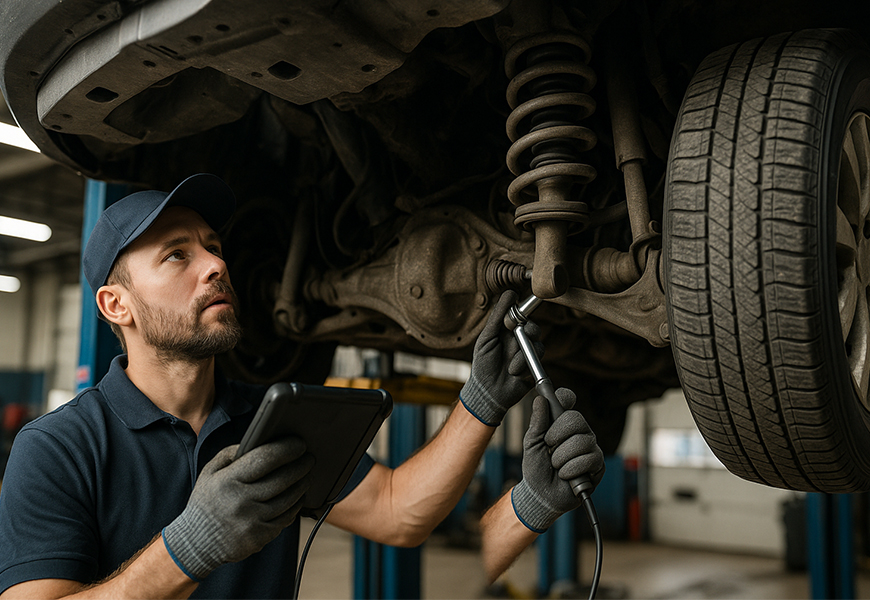Suspension Diagnostics and Repair: A Complete Guide for Car Owners

The suspension system of a car is the foundation of comfort, stability, and safety on the road. It ensures proper road grip, absorbs shocks, and provides handling and cornering stability. That’s why even a minor fault in the suspension or steering system can lead to a dangerous situation or costly repairs.
In this article, we’ll explain:
- what symptoms indicate suspension problems;
- the most common issues and their causes;
- how diagnostics and repairs are carried out;
- and why you shouldn’t delay a visit to a service center.
Symptoms of Suspension Problems
The suspension system is the first to “feel” bad roads — and the first to signal when something’s wrong. Here are the most common signs that your car needs attention:
- Knocking or creaking noises while driving: often occur on bumps or turns. Usually caused by worn ball joints, stabilizer bushings, or control arm bushings.
- The car pulls to one side: possible reasons include misalignment, uneven tire wear, or a faulty steering rack.
- Steering wheel or body vibration at high speeds: often caused by wheel imbalance, warped rims, or worn wheel bearings.
- Overly stiff or soft suspension: may indicate problems with shocks or springs.
- Humming or droning noise while driving: could signal worn bearings or driveshaft issues.
Ignoring these symptoms can lead to complete loss of control or very expensive repairs!

Most Common Suspension System Failures
Drivers most often visit service centers with the following problems:
| Fault | Symptoms | Possible Consequences |
| Worn shock absorbers | Poor shock absorption, longer braking distance | Loss of control, risk of rollover |
| Damaged ball joints | Knocking, looseness, squeaking | Wheel detachment, accident risk |
| Worn control arm bushings | Knocking, unstable handling | Suspension deformation |
| Worn wheel bearings | Humming noise, vibration | Wheel seizure |
| Worn stabilizer bushings | Knocking, excessive body roll in turns | Loss of stability |
| Incorrect wheel alignment | Rapid tire wear, car pulls to one side | Reduced handling |
| Damaged control arms | Knocking after bumps, misaligned geometry | Unstable vehicle behavior |
How Suspension Diagnostics Are Performed
A full suspension inspection includes:
- Visual inspection — checking shocks, control arms, bushings, ball joints, and other components.
- Checking for play — using special tools to measure clearances in joints.
- Shock absorber testing on a stand — determines their damping efficiency.
- Inspection of bearings and joints — assessing wear, noise, and looseness.
- Wheel alignment check — performed using laser or computerized equipment.
- Computer diagnostics — reading error codes in systems such as ABS, ESP, or adaptive suspension.
After diagnostics, you’ll receive a detailed report and clear recommendations on which components require repair or replacement.
How Suspension Repair Is Carried Out
Depending on diagnostic results, the following types of suspension repair work are performed:
- Replacement of shocks, springs, ball joints, and bushings;
- Repair or replacement of control arms and stabilizer bars;
- Servicing of the steering system (tie rods, ends, rack);
- Wheel alignment adjustment after repairs;
- Inspection and replacement of wheel bearings.
All work is performed using high-quality parts, proper torque settings, and manufacturer specifications.
Why Timely Repair Matters
A worn suspension is not just about noise or discomfort — it’s a real safety risk:
- loss of stability in corners;
- increased braking distance;
- risk of losing control.
Moreover, delaying repairs can cause a chain reaction of multiple component failures, leading to significantly higher repair costs.
Where to Get Suspension Diagnostics and Repair
Looking for professional suspension service in your city? Choose a workshop that offers:
- experience with different car brands;
- modern diagnostic equipment;
- warranty on performed work;
- transparent pricing and qualified mechanics.
Conclusion
The suspension system is a key element of your car’s safety. Don’t ignore the first warning signs — it’s always better to diagnose issues early than to spend money on major repairs or risk an accident.
Book your suspension diagnostics today — it’s quick, affordable, and ensures peace of mind on the road.
